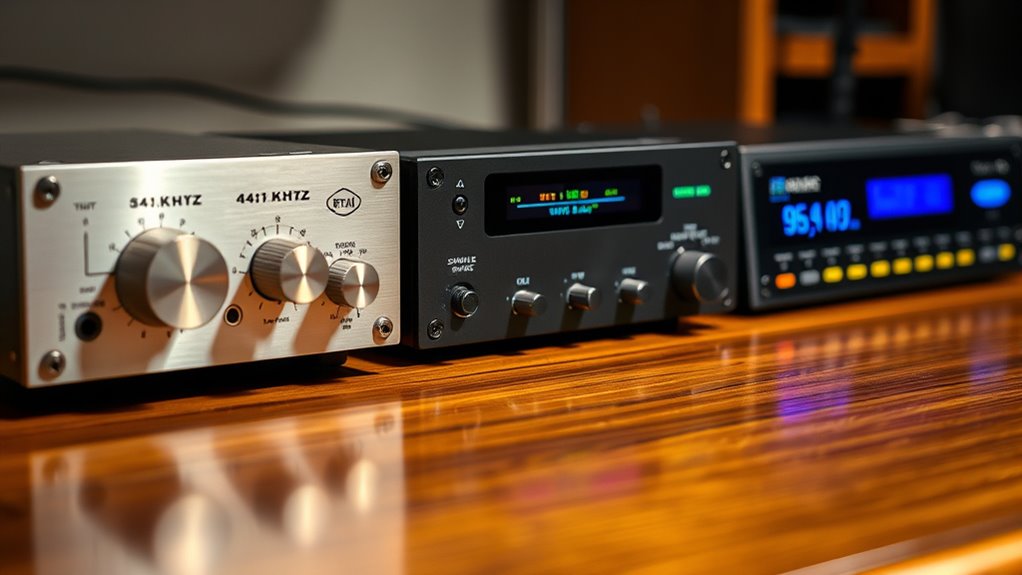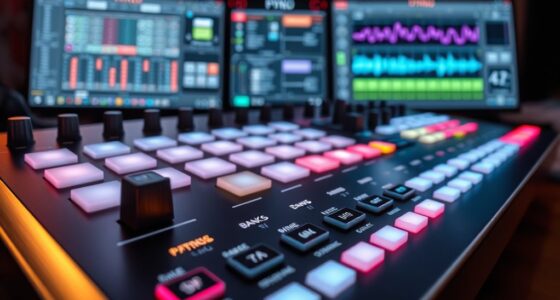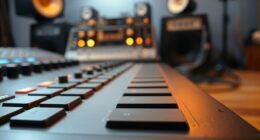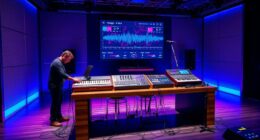Choosing between 44.1 kHz, 48 kHz, and 96 kHz depends on your project needs. 44.1 kHz is ideal for music and streaming, offering excellent quality with lower file sizes. 48 kHz works well for video and professional multimedia, providing better detail and synchronization. 96 kHz offers maximum fidelity for high-resolution recordings but requires more storage and power. Understanding these options helps optimize your sound quality—dive in to discover which suits your workflow best.
Key Takeaways
- 44.1 kHz is ideal for consumer music and streaming, accurately reproducing human hearing up to 20 kHz.
- 48 kHz is standard for professional video and multimedia, offering better synchronization and reduced artifacts.
- 96 kHz provides higher detail and wider frequency response, suitable for high-resolution recordings and sound design.
- Higher sample rates like 96 kHz demand more storage and processing power, making them less practical for everyday use.
- Choose 44.1 kHz for general listening, 48 kHz for multimedia projects, and 96 kHz for specialized, high-fidelity applications.

Choosing the right sample rate is essential for capturing high-quality audio or accurately digitizing analog signals. It determines how often the analog waveform is sampled per second, directly impacting the audio’s clarity and detail. When selecting a sample rate, you also need to consider bit depth, which influences audio fidelity by defining how precisely each sample captures the amplitude of the sound wave. A higher bit depth allows for more dynamic range and less noise, ensuring the sound remains true to the original. Balancing sample rate and bit depth is key to achieving ideal audio quality.
Selecting the right sample rate and bit depth ensures optimal audio clarity and fidelity.
In the debate between 44.1 kHz, 48 kHz, and 96 kHz, your choice hinges on your specific needs. The 44.1 kHz rate is the standard for consumer music playback, primarily because it aligns with the CD format. It’s sufficient to accurately reproduce audible frequencies up to about 20 kHz, which covers the full range of human hearing. If you’re working on music production or streaming, 44.1 kHz with a good bit depth—like 16 or 24 bits—delivers excellent audio fidelity without demanding excessive storage or processing power.
Switching to 48 kHz offers a slight increase in sample rate, making it the standard for professional video and film production. It captures more detail, particularly in higher frequencies, which can be beneficial for post-production editing or synchronization with video content. This rate also preserves audio fidelity better during processing, as it reduces aliasing and other artifacts that might occur at lower sample rates. If your projects involve multimedia or broadcast media, 48 kHz is typically the best choice.
Moving up to 96 kHz provides even greater detail and a wider frequency response. It’s favored in high-resolution audio recordings, mastering, and professional sound design, where every nuance counts. However, higher sample rates demand more storage space and processing power. While 96 kHz can theoretically improve audio fidelity, the human ear may not perceive all the extra detail, especially if your bit depth remains the same. Hence, it’s most useful when combined with a high bit depth and used in contexts where maximum audio accuracy is paramount. Additionally, understanding sample rate choices can help you optimize your audio workflow effectively.
Frequently Asked Questions
How Do Sample Rate Choices Affect File Sizes?
Choosing a higher sample rate increases your file size because it captures more audio data per second. This affects the overall audio resolution, making recordings clearer, especially at higher rates like 96 kHz. When you select a higher sample rate, guarantee your bit depth remains consistent, as it also influences file size and sound quality. So, balancing sample rate and bit depth helps you manage file size while maintaining desired audio fidelity.
Can Higher Sample Rates Improve Audio Quality for Everyday Listening?
Higher sample rates can slightly improve audio quality for everyday listening, especially if you use higher bit depths, which add more detail and dynamic range. However, beyond a certain point, you might not notice significant differences, and digital artifacts could become more noticeable if the recording isn’t well-managed. For most casual listening, sticking to 44.1 or 48 kHz is usually sufficient, but 96 kHz can offer extra detail if your gear supports it.
Are There Compatibility Issues With Different Audio Devices?
You might face device compatibility issues when using different audio devices, especially if hardware limitations prevent proper playback at higher sample rates. Some devices can’t handle 96 kHz or even 48 kHz, causing playback problems or reduced quality. Always check your device specifications before choosing a sample rate, and consider sticking to common standards like 44.1 kHz for broader compatibility and smoother listening experiences.
How Do Sample Rates Impact Editing and Mixing Processes?
Ever wondered how sample rates impact your editing and mixing? Higher sample rates, like 96kHz, give you more detail, but demand more from your hardware processing capabilities and can complicate bit depth considerations. Lower rates, like 44.1kHz, simplify your workflow and reduce processing strain. Choosing the right sample rate helps you balance audio quality with system performance, making your editing smoother and more efficient.
Is There a Noticeable Difference in Streaming Audio Quality?
You might notice a slight difference in streaming audio quality based on sample rate, but it’s often subtle. Higher sample rates, like 96 kHz, can improve audio fidelity, especially in professional settings, but for most streaming, the impact is minimal. Bit depth also plays a role, influencing dynamic range. Ultimately, your listening environment and equipment matter more than the sample rate alone for perceived audio quality.
Conclusion
Ultimately, choosing your sample rate is like selecting the perfect lens for your creative vision. Whether you opt for the warm glow of 44.1 kHz, the balanced clarity of 48 kHz, or the crisp sharpness of 96 kHz, each setting offers its own subtle charm. Trust your instincts and imagine the journey your sound will take—like a gentle breeze guiding your project to its final, polished bloom. Your ideal choice will help your audio naturally flourish.










